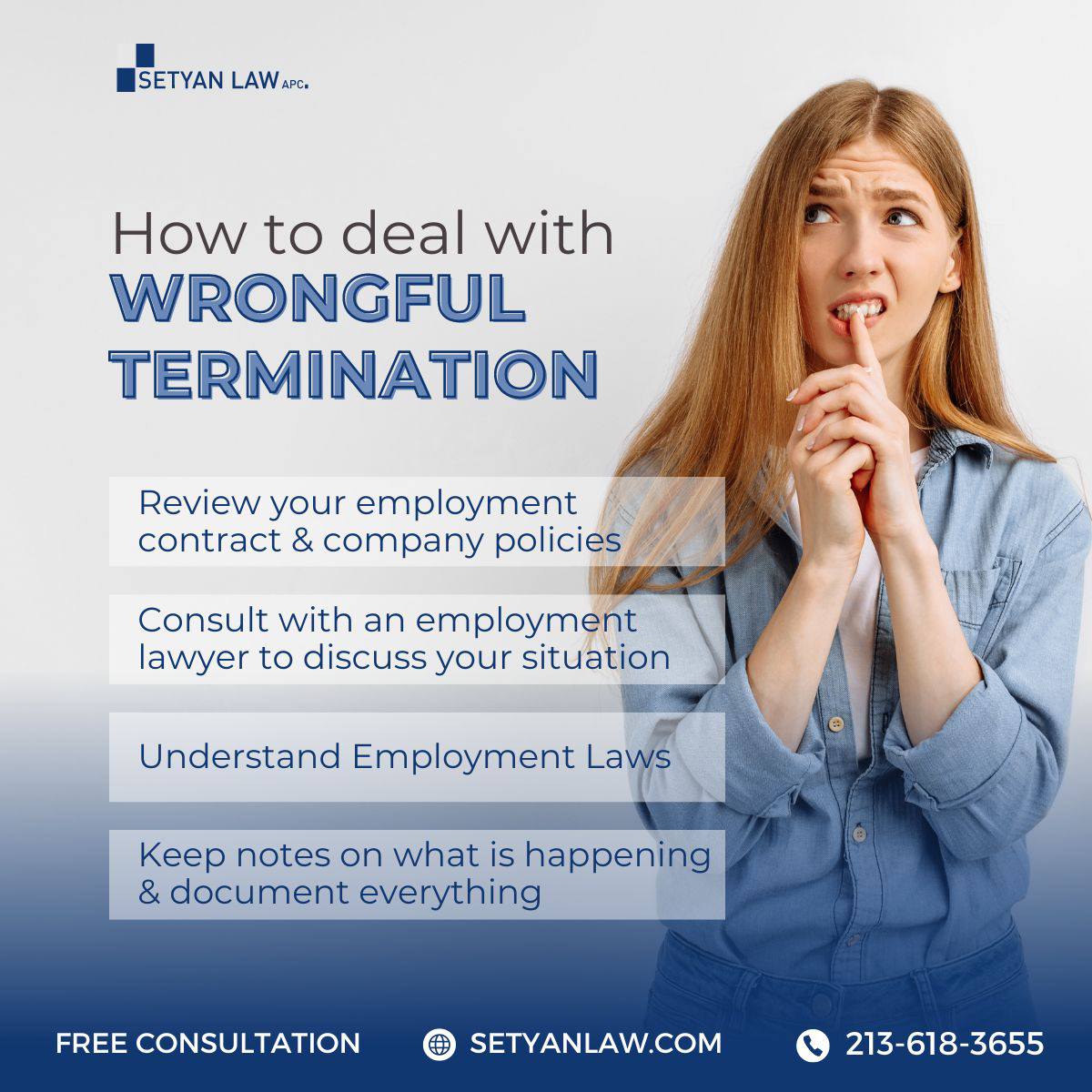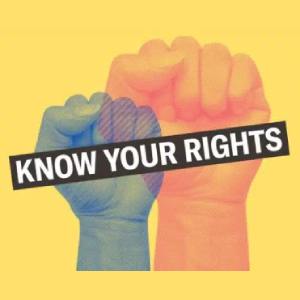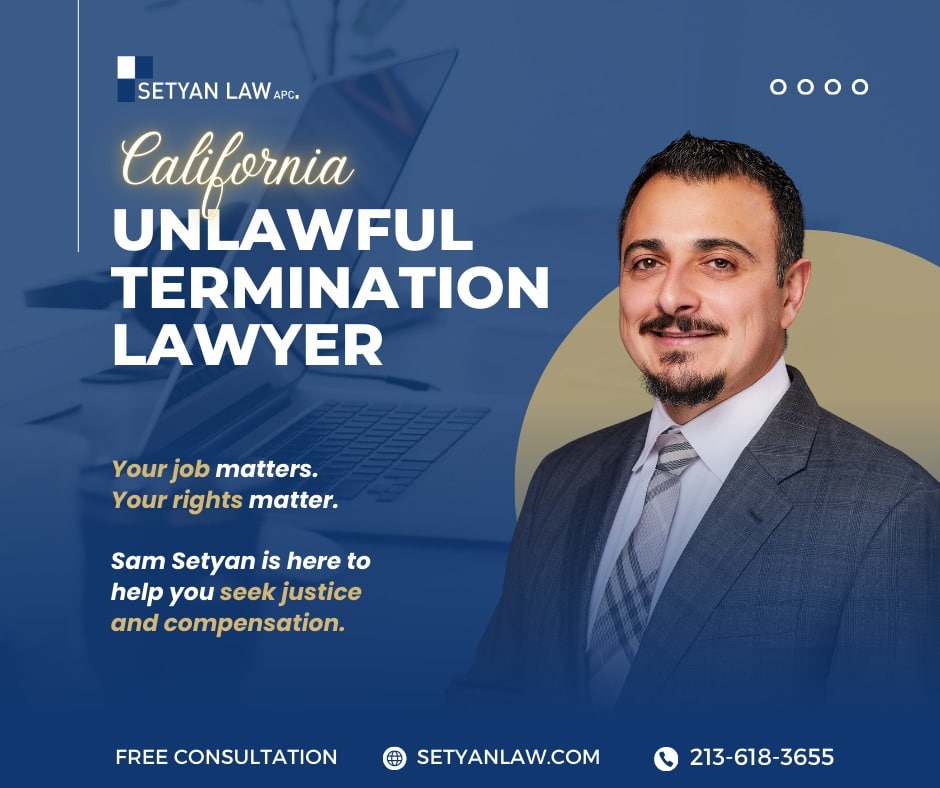Updated February 21, 2025
Navigating Unfair Termination: Your Rights and Legal Options
Losing your job unexpectedly can be a devastating experience, especially if you believe the termination was unjust. While California follows the "at-will" employment doctrine, which generally allows employers to terminate employees for any reason, there are important exceptions that protect workers from unfair dismissal. Understanding your rights and the legal landscape surrounding wrongful termination is crucial for determining your next steps and potentially seeking justice.
When faced with an unfair firing, it’s natural to feel overwhelmed and unsure of how to proceed. This comprehensive guide will walk you through the key aspects of wrongful termination in California, helping you understand your rights, recognize potential violations, and explore your legal options. By arming yourself with knowledge and taking appropriate action, you can protect your interests and hold employers accountable for unlawful practices.
Understanding At-Will Employment and Its Limitations
At-will employment doctrine provides employers with significant flexibility in hiring and firing decisions. However, this flexibility is not absolute. There are several important exceptions and protections that limit an employer’s ability to terminate employees arbitrarily or for illegal reasons.
The Basics of At-Will Employment
At its core, at-will employment means that both the employer and employee can end the working relationship at any time, for any reason, or for no reason at all. This arrangement provides flexibility for both parties but can leave employees feeling vulnerable to sudden job loss.
Key Exceptions to At-Will Employment
While the at-will doctrine is the default in California, several crucial exceptions exist to protect employees from unfair termination:
Discrimination: Employers cannot fire employees based on protected characteristics such as race, gender, age, religion, disability, or sexual orientation.
Retaliation: It is illegal to terminate an employee for exercising their legal rights, such as reporting workplace safety violations or filing a workers’ compensation claim.
Public Policy Violations: Employers cannot fire workers for reasons that violate public policy, such as refusing to engage in illegal activities.
Breach of Contract: If an employment contract exists (written, verbal, or implied), the employer must adhere to its terms regarding termination.
Whistleblower Protections: Employees who report illegal activities or violations of public policy are protected from retaliatory termination.
Understanding these exceptions is crucial for recognizing when a termination may be unlawful and actionable under California law.
Recognizing Signs of Wrongful Termination
Identifying whether your termination was potentially unlawful requires careful consideration of the circumstances surrounding your dismissal. Here are some red flags that may indicate wrongful termination:
Timing of Termination
Pay attention to the timing of your firing in relation to other events:
- Were you terminated shortly after filing a complaint about workplace harassment or discrimination?
- Did your dismissal occur soon after you took protected leave, such as medical or family leave?
- Were you fired after refusing to participate in illegal activities or reporting safety violations?
Suspicious timing can be a strong indicator of retaliatory termination.
Inconsistent Treatment
Consider whether you were treated differently from other employees in similar situations:
- Were you held to higher standards or subjected to harsher disciplinary actions than your colleagues?
- Did the company deviate from its usual termination procedures in your case?
- Were you denied opportunities or promotions that were given to less qualified coworkers?
Inconsistent treatment may suggest discriminatory motives behind the termination.
Lack of Documentation or Clear Reasoning
Employers often document performance issues or policy violations before terminating an employee. Be wary if:
- You were fired without any prior warnings or performance improvement plans.
- The reasons given for your termination are vague or inconsistent with your work history.
- Your employer refuses to provide a written explanation for your dismissal.
A lack of documentation or clear reasoning may indicate that the stated reasons for termination are pretextual.
Violation of Company Policies or Procedures
Review your employee handbook and company policies to determine if proper procedures were followed:
- Did your employer adhere to their own disciplinary and termination policies?
- Were you given appropriate notice or severance as outlined in company guidelines?
- Was your termination handled in a manner consistent with how other employees were treated?
Deviations from established policies can suggest unfair treatment or ulterior motives.
Common Grounds for Wrongful Termination Claims
Understanding the most frequent bases for wrongful termination claims can help you assess whether your situation may warrant legal action. Here are the primary grounds on which employees often challenge their dismissals:
Discrimination
California’s Fair Employment and Housing Act (FEHA) prohibits employment discrimination based on protected characteristics, including:
- Race, color, or national origin
- Gender, gender identity, or sexual orientation
- Age (40 and older)
- Religion or creed
- Disability or medical condition
- Marital status
- Pregnancy or related conditions
- Military or veteran status
If you believe your termination was motivated by any of these factors, you may have grounds for a discrimination claim.
Retaliation
Employers cannot fire employees for engaging in legally protected activities, such as:
- Reporting workplace harassment or discrimination
- Filing a workers’ compensation claim
- Requesting reasonable accommodations for a disability
- Participating in union activities
- Reporting safety violations or other illegal conduct (whistleblowing)
Retaliation claims are among the most common types of wrongful termination lawsuits in California.
Breach of Contract
If you have an employment contract (written, verbal, or implied), your employer must adhere to its terms regarding termination. Potential breaches include:
- Firing you without cause if the contract specifies termination only for cause
- Failing to follow agreed-upon disciplinary procedures
- Terminating you before the end of a specified contract term without proper justification
Even if you don’t have a formal written contract, implied agreements based on company policies or consistent assurances of job security may create contractual obligations.
Violation of Public Policy
Employers cannot terminate employees for reasons that violate fundamental public policies. Examples include:
- Firing an employee for refusing to engage in illegal activities
- Terminating a worker for reporting illegal conduct to authorities
- Dismissing an employee for taking time off for jury duty or voting
These protections ensure that employees are not forced to choose between their jobs and their civic duties or legal obligations.
Steps to Take If You Suspect Wrongful Termination
If you believe you’ve been wrongfully terminated, taking prompt and strategic action is crucial to protect your rights and build a strong case. Here’s a step-by-step guide on how to proceed:
1. Document Everything
Start by creating a detailed record of the events leading up to and including your termination:
- Write down the date, time, and circumstances of your firing
- Note any conversations or interactions related to your dismissal
- Gather relevant emails, performance reviews, and other documentation
- List potential witnesses who may have observed discriminatory or retaliatory behavior
Thorough documentation can be invaluable if you decide to pursue legal action.
2. Request a Written Explanation
If you haven’t already received one, ask your employer for a written explanation of the reasons for your termination. This document can be crucial evidence, especially if the stated reasons are inconsistent or pretextual.
3. Review Your Employment Contract and Company Policies
Carefully examine any employment agreements, employee handbooks, or company policies that may apply to your situation. Look for:
- Procedures for termination and disciplinary actions
- Promised job protections or security assurances
- Grievance processes or appeal procedures
Understanding your contractual rights and company policies can help you identify potential violations.
4. File an Internal Complaint
If your company has a formal grievance process, consider filing an internal complaint. This step can:
- Create an official record of your concerns
- Potentially lead to an internal investigation
- Demonstrate that you’ve attempted to resolve the issue through proper channels
Be aware that filing an internal complaint may not always be advisable, especially if you fear further retaliation. Consult with an attorney before taking this step.
5. Consult with an Employment Attorney
Speaking with an experienced employment lawyer is crucial for understanding your rights and options. An attorney can:
- Evaluate the strength of your case
- Advise you on the best course of action
- Help you navigate complex legal procedures
- Represent your interests in negotiations or litigation
Many employment attorneys offer free initial consultations, allowing you to explore your options without financial commitment.
6. File a Complaint with Government Agencies
Depending on the nature of your claim, you may need to file a complaint with the appropriate government agency before pursuing a lawsuit:
- For discrimination or retaliation claims under FEHA, file with the California Civil Rights Department (CRD) within three years of the termination.
- For federal discrimination claims, file with the Equal Employment Opportunity Commission (EEOC) within 300 days.
These agencies can investigate your complaint and may attempt to resolve the issue through mediation or other means.
7. Consider Legal Action
If other avenues fail to resolve your wrongful termination issue, you may choose to file a lawsuit against your former employer. Potential legal remedies include:
- Reinstatement to your former position
- Back pay and benefits
- Compensatory damages for emotional distress
- Punitive damages in cases of egregious employer conduct
- Attorney’s fees and legal costs
The decision to pursue litigation should be made carefully, with consideration of the potential benefits and risks involved.
Legal Remedies and Potential Compensation
Understanding the potential outcomes of a successful wrongful termination claim can help you weigh the benefits of legal action. Here are the primary forms of relief available to wrongfully terminated employees in California:
Reinstatement
In some cases, the court may order your employer to rehire you in your former position or a comparable role. However, reinstatement is not always practical or desirable, especially if the relationship with your employer has become too strained.
Back Pay and Benefits
You may be entitled to recover lost wages and benefits from the date of your termination to the date of judgment or settlement. This compensation aims to put you in the financial position you would have been in had you not been wrongfully terminated.
Front Pay
If reinstatement is not feasible, the court may award front pay to compensate for future lost earnings. The amount is typically based on factors such as your age, career prospects, and the likelihood of finding comparable employment.
Compensatory Damages
These damages are intended to compensate you for non-economic losses such as emotional distress, pain and suffering, and damage to your professional reputation resulting from the wrongful termination.
Punitive Damages
In cases where the employer’s conduct was particularly egregious or malicious, punitive damages may be awarded to punish the employer and deter similar behavior in the future. California law places certain restrictions on punitive damages, but they can still be substantial in some cases.
Attorney’s Fees and Costs
If you prevail in your wrongful termination lawsuit, the court may order your former employer to pay your reasonable attorney’s fees and legal costs. This provision helps ensure that employees can pursue valid claims even if they cannot afford to pay for legal representation upfront.
Injunctive Relief
The court may issue orders requiring your former employer to take specific actions or refrain from certain behaviors. This could include mandating changes to company policies or practices to prevent future violations.
It’s important to note that the specific remedies available and the potential value of your claim will depend on various factors, including the strength of your evidence, the nature of the violation, and your individual circumstances. An experienced employment attorney can help you assess the potential value of your case and develop a strategy to maximize your recovery.
Statute of Limitations and Timely Action
When dealing with wrongful termination, understanding and adhering to legal deadlines is crucial. The statute of limitations sets strict time limits for filing a claim, and failing to act within these timeframes can result in losing your right to seek legal recourse. Here’s what you need to know about timing your action:
General Statute of Limitations
In California, the general statute of limitations for wrongful termination claims is two years from the date of termination. This applies to most claims based on breach of contract or violation of public policy.
Discrimination and Retaliation Claims
For claims filed under the California Fair Employment and Housing Act (FEHA), you have three years from the date of the adverse employment action to file a complaint with the California Civil Rights Department (CRD). After receiving a right-to-sue notice from the CRD, you have one year to file a lawsuit in court.
Federal Claims
If you’re filing a claim under federal law, such as Title VII of the Civil Rights Act, you must file a charge with the Equal Employment Opportunity Commission (EEOC) within 300 days of the discriminatory act. After receiving a right-to-sue letter from the EEOC, you have 90 days to file a federal lawsuit.
Exceptions and Special Circumstances
Certain situations may extend or alter the standard statutes of limitations:
- Continuing Violations: If the unlawful conduct is ongoing, the statute of limitations may be extended.
- Discovery Rule: In some cases, the clock may start when you discovered (or reasonably should have discovered) the wrongful act, rather than when it occurred.
- Tolling Agreements: You and your employer may agree to extend the filing deadline while attempting to resolve the dispute.
Importance of Prompt Action
While these deadlines may seem generous, it’s crucial to act promptly for several reasons:
- Evidence Preservation: Important documents and witness memories can fade or become unavailable over time.
- Stronger Case Building: Early action allows for more thorough investigation and preparation of your claim.
- Potential for Earlier Resolution: Addressing the issue promptly may lead to quicker resolution through negotiation or settlement.
- Avoiding Procedural Pitfalls: Complex filing requirements and deadlines can be navigated more effectively with ample time.
Given the complexities surrounding statutes of limitations and the potential for exceptions, it’s advisable to consult with an employment attorney as soon as possible after your termination. An experienced lawyer can help ensure that you meet all necessary deadlines and preserve your right to seek justice.
Navigating the Legal Process
Pursuing a wrongful termination claim can be a complex and lengthy process. Understanding the general steps involved can help you prepare for what lies ahead:
Initial Consultation and Case Evaluation
Your journey typically begins with a consultation with an employment attorney. During this meeting, the lawyer will:
- Review the facts of your case
- Assess the strength of your claim
- Explain your legal options and potential outcomes
- Discuss their fee structure and representation terms
This is your opportunity to ask questions and determine if the attorney is a good fit for your needs.
Investigation and Evidence Gathering
If you decide to move forward, your attorney will conduct a thorough investigation, which may include:
- Collecting and reviewing relevant documents
- Interviewing witnesses
- Analyzing company policies and practices
- Consulting with experts if necessary
This phase is crucial for building a strong case and identifying potential weaknesses.
Filing Administrative Complaints
Depending on the nature of your claim, you may need to file a complaint with a government agency such as the CRD or EEOC before proceeding to court. Your attorney will guide you through this process, ensuring all necessary information is included and deadlines are met.
Negotiation and Settlement Discussions
Many wrongful termination cases are resolved through negotiation before reaching trial. Your attorney may engage in settlement discussions with your former employer’s representatives to seek a favorable resolution without the need for litigation.
Filing a Lawsuit
If a settlement cannot be reached, your attorney will file a lawsuit on your behalf. This involves drafting and filing a complaint that outlines your allegations and the legal basis for your claim.
Discovery Phase
Once the lawsuit is filed, both sides engage in the discovery process, which involves:
- Exchanging relevant documents
- Taking depositions of witnesses
- Submitting and responding to written questions (interrogatories)
- Potentially engaging in mediation or settlement conferences
This phase can be time-consuming but is essential for preparing for trial.
Pre-Trial Motions
Before trial, either side may file motions to resolve certain issues or potentially dismiss the case. Your attorney will handle these legal arguments on your behalf.
Trial
If your case proceeds to trial, it will typically involve:
- Jury selection (in some cases)
- Opening statements
- Presentation of evidence and witness testimony
- Closing arguments
- Jury deliberation and verdict (in jury trials)
Trials can last anywhere from a few days to several weeks, depending on the complexity of the case.
Post-Trial Proceedings
After the trial, there may be additional proceedings such as:
- Filing post-trial motions
- Negotiating the specific terms of relief awarded
- Potentially appealing the decision
Throughout this process, your attorney will advocate for your interests and keep you informed of developments in your case. While the legal journey can be challenging, understanding these steps can help you navigate the process with greater confidence and preparedness.
Protecting Your Rights and Future Employment
While pursuing legal action for wrongful termination is important, it’s equally crucial to take steps to protect your rights and future employment prospects. Here are some key considerations:
Maintain Professionalism
Even if you feel your termination was unfair, it’s essential to maintain a professional demeanor:
- Avoid making negative public statements about your former employer
- Refrain from discussing your case on social media
- Be cautious about what you say to coworkers or industry colleagues
Maintaining professionalism can protect your reputation and avoid potential legal complications.
Secure References
If possible, try to secure positive references from supervisors or colleagues who can speak to your skills and work ethic. These references can be valuable for future job applications.
Review and Negotiate Severance Agreements
If you’re offered a severance package, review it carefully before signing:
- Understand what rights you may be waiving by accepting the agreement
- Consider negotiating for better terms, especially if you suspect wrongful termination
- Consult with an attorney before signing any severance agreement
Protect Your Professional Reputation
Take proactive steps to maintain your professional standing:
- Update your LinkedIn profile and resume to reflect your accomplishments
- Engage in professional development activities or volunteer work to stay current in your field
- Network with industry contacts to keep abreast of opportunities
Document Your Job Search Efforts
If you’re seeking damages for lost wages, it’s important to demonstrate that you’ve made efforts to find new employment:
- Keep a log of job applications, interviews, and networking activities
- Save rejection letters or correspondence related to your job search
- Document any interim employment or freelance work you undertake
This documentation can support your claim for damages and demonstrate your efforts to mitigate losses.
Consider Career Counseling or Coaching
Professional guidance can be valuable in navigating your career transition:
- Explore new career paths or industries
- Improve your job search strategies
- Address any confidence issues resulting from the termination
Be Prepared for Future Job Interviews
When interviewing for new positions, be prepared to address your termination professionally:
- Develop a concise, neutral explanation for your departure
- Focus on your skills, accomplishments, and what you can offer to a new employer
- Avoid speaking negatively about your former employer
Seek Emotional Support
Dealing with wrongful termination can be emotionally challenging. Don’t hesitate to seek support:
- Consider counseling or therapy to process your emotions
- Join support groups for individuals facing similar challenges
- Lean on friends and family for emotional support
Remember, wrongful termination is a reflection of your employer’s actions, not your worth as a professional. By taking proactive steps to protect your rights and future prospects, you can emerge from this challenging experience stronger and well-positioned for future success.
Conclusion: Empowerment Through Knowledge and Action
Facing wrongful termination can be one of the most challenging experiences in your professional life. It’s not just about losing a job; it’s about confronting injustice, protecting your rights, and safeguarding your future career prospects. Throughout this guide, we’ve explored the complex landscape of wrongful termination in California, from understanding your rights to navigating the legal process and beyond.
Key takeaways to remember:
Know Your Rights: Understanding the exceptions to at-will employment and recognizing signs of wrongful termination is crucial.
Act Promptly: Time is of the essence in wrongful termination cases. Document everything and seek legal advice as soon as possible.
Explore All Options: From internal complaints to government agency filings and lawsuits, there are multiple avenues for seeking justice.
Protect Your Future: While pursuing legal action, take steps to safeguard your professional reputation and future employment opportunities.
Seek Support: Don’t underestimate the emotional toll of wrongful termination. Seek professional and personal support as needed.
Remember, you are not alone in this journey. Many employees have successfully challenged unfair dismissals and secured justice. By arming yourself with knowledge, seeking appropriate legal guidance, and taking strategic action, you can stand up for your rights and work towards a positive resolution.
Wrongful termination cases are often complex, and outcomes can vary widely based on individual circumstances. However, by understanding your rights and the legal landscape, you’re better equipped to make informed decisions and take appropriate action. Whether your next step is consulting with an attorney, filing a complaint, or negotiating with your former employer, approach it with confidence, knowing that you’re taking proactive steps to protect your rights and your future.
Your career is more than just a job—it’s a significant part of your life and identity. By standing up against wrongful termination, you’re not only fighting for your own rights but also contributing to a fairer workplace for all employees. Stay resilient, stay informed, and remember that with the right approach and support, you can overcome this challenge and move forward towards a brighter professional future.
If you’re employed by a California employer, contact an expert employment attorney first, for expert assistance regarding your case. Call today for a free and confidential consultation.








